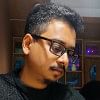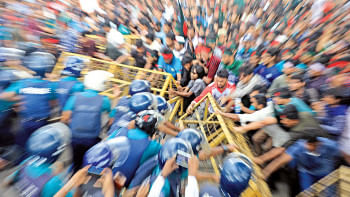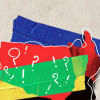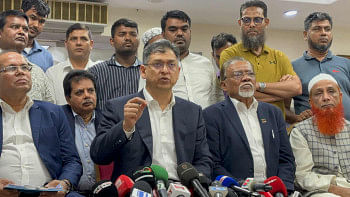Remembering Abu Sayed: The day fear died

I did not know Abu Sayed. Not even his name, until after he had died. But even then, I distinctly remember the moment I saw him being shot.
At that point in the quota reform movement, most people were silently hoping that someone would step forward to support the public university students, who had been brutally beaten the day before by Chhatra League goons. Yet, the predominant fear was that the students would soon be beaten so mercilessly that the entire movement would be crushed.
This left a deep sense of unease all around.
It was after lunch at the office. In between tasks, I instinctively began scrolling through whatever footage was available to see what was unfolding. Eventually, I clicked on what I (mistakenly) thought was a livestream of the protests.
The first few seconds were chaotic—shifting scenes of violence and loud, terrorising sounds. Then, within minutes, a young man appeared on screen. Standing a few feet ahead of the other protesters, arms outstretched, he was gesturing to those in front of him that he meant them no harm and that any harm directed at those behind him would have to go through him.
It was not only a remarkable act of courage, but also of faith—faith that those facing him would not harm him, even though he had left himself completely vulnerable to them. He flinched for just a brief moment, seemingly struck by something, before resuming his extraordinary stance.
The video then showed him flinching a couple more times before switching to more chaotic scenes. Within minutes, it switched back to the young man, now squatting on the road, with someone standing beside him. And a few moments later, the video showed him being carried away by three or four individuals.
Having seen those scenes, I returned to work.
Shortly after, news arrived that one person had been killed during the protests. Details about the death started to pour in, one after the other. The first thing I remember hearing was that the killing had taken place in Rangpur. The next was his name: Abu Sayed.
Throughout the rest of the day, we were all silently praying for the protesters, our imaginations running wild as to what was happening to them on the streets. News of more deaths began to come in, although the situation remained relatively unclear, with speculation running rife. But the general belief was: "this is it." The Awami regime had done what it had always done over the past 15 years—used the full force of the state to successfully quell the protests. That everyone would get the message: protest, and you will pay with your limbs and your life. And having gotten that message, they would back down, too afraid to take to the streets.
That is what had happened again and again during the Awami League's 15-year reign.
But the next morning, I remember seeing Sayed's picture on the front page of this daily. Standing there, arms outstretched. Unafraid of death. And something shifted.
The newspaper was closed that day on the occasion of Ashura. Coincidentally, it was also my birthday. Someone close to me had planned a dinner for me with friends. But that morning, all we could think about were the protests. I remember watching students from various public universities say they would not leave their halls. Their defiance made my morning. But by the end of the day, through even more violence, the government had started to clear out most public university halls.
I was too depressed for any dinners or celebrations. Instead, in the evening, with a couple of friends, I watched Sheikh Hasina deliver yet another disgraceful address to the nation.
The next day, there was more violence as private university students took to the streets. Casualties started to pile up. Injuries were being reported left, right, and centre. However, the violence didn't matter anymore. Yes, there was sympathy for the injured. Grief for the dead and their families. But the fear was gone. Because Abu Sayed had stood there.
Despite knowing how far the Awami regime was willing to go to stay in power and carry on with its despicable acts, it was difficult—even for a journalist—to fathom the lengths it would go to in the following weeks. I had stood in front of the former home minister's residence 30 minutes before helicopters reportedly fired on people. Yet, when I initially heard about it from people I knew, who lived around Dhanmondi Road-5, I didn't believe it at first.
Although the fear of what might happen to others was there, what might happen to me was gone. Because Abu Sayed had stood there.
In earlier days, when the students were getting mauled by Chhatra League and law enforcers, there were moments when we had hoped that the students would just get off the streets. Because we did not want them to endure any more cruelty. But now, I, myself, started joining the protests after work. And anyone who asked how they could join, we would refer to events that we knew were happening. Because Abu Sayed had stood there.
Over the next days, one by one, everyone I knew started to say that this regime would surely fall. Because Abu Sayed had stood there.
And now that he was gone, someone else would stand there. And that if they too fell, we, ourselves, would stand there. Because we all wanted to be Abu Sayed.
Whereas before July 16, we were all hoping "someone else" would do something. After what Sayed did, we gave up on that hope. Instead, we learned to act, ourselves.
And once all of us felt that way, it was over. Our freedom from the oppressive Awami regime was all but guaranteed.
Today, the feeling Abu Sayed had instilled in us has left. We have gone back to hoping that someone else would do something. Blaming others for whatever is happening around us.
Perhaps, as we look back on that image of Sayed today, that feeling will return, however briefly. That, like Sayed, we must not step back. We must put ourselves on the front line. That, as individuals, we must take a stand for justice. And if enough of us collectively do that—just as Sayed inspired us to, nearly a year ago—the dreams of our July martyrs can surely be turned into reality.
Eresh Omar Jamal is the head of the editorial department at The Daily Star. His X handle is @EreshOmarJamal.
Views expressed in this article are the author's own.
Follow The Daily Star Opinion on Facebook for the latest opinions, commentaries and analyses by experts and professionals. To contribute your article or letter to The Daily Star Opinion, see our guidelines for submission.

 For all latest news, follow The Daily Star's Google News channel.
For all latest news, follow The Daily Star's Google News channel. 











Comments